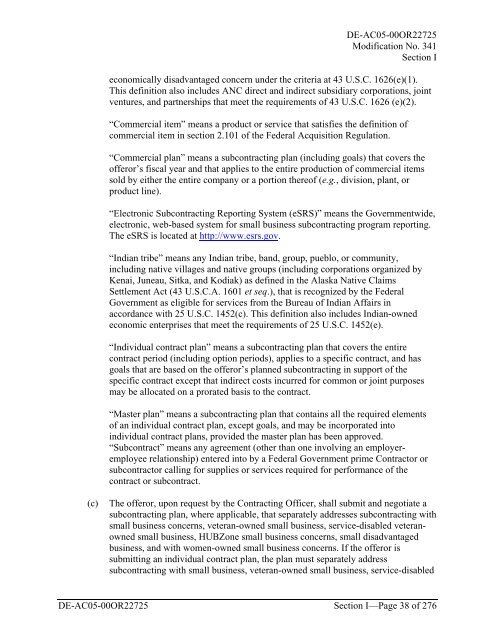part ii - contract clauses
part ii - contract clauses
part ii - contract clauses
You also want an ePaper? Increase the reach of your titles
YUMPU automatically turns print PDFs into web optimized ePapers that Google loves.
DE-AC05-00OR22725<br />
Modification No. 341<br />
Section I<br />
economically disadvantaged concern under the criteria at 43 U.S.C. 1626(e)(1).<br />
This definition also includes ANC direct and indirect subsidiary corporations, joint<br />
ventures, and <strong>part</strong>nerships that meet the requirements of 43 U.S.C. 1626 (e)(2).<br />
“Commercial item” means a product or service that satisfies the definition of<br />
commercial item in section 2.101 of the Federal Acquisition Regulation.<br />
“Commercial plan” means a sub<strong>contract</strong>ing plan (including goals) that covers the<br />
offeror’s fiscal year and that applies to the entire production of commercial items<br />
sold by either the entire company or a portion thereof (e.g., division, plant, or<br />
product line).<br />
“Electronic Sub<strong>contract</strong>ing Reporting System (eSRS)” means the Governmentwide,<br />
electronic, web-based system for small business sub<strong>contract</strong>ing program reporting.<br />
The eSRS is located at http://www.esrs.gov.<br />
“Indian tribe” means any Indian tribe, band, group, pueblo, or community,<br />
including native villages and native groups (including corporations organized by<br />
Kenai, Juneau, Sitka, and Kodiak) as defined in the Alaska Native Claims<br />
Settlement Act (43 U.S.C.A. 1601 et seq.), that is recognized by the Federal<br />
Government as eligible for services from the Bureau of Indian Affairs in<br />
accordance with 25 U.S.C. 1452(c). This definition also includes Indian-owned<br />
economic enterprises that meet the requirements of 25 U.S.C. 1452(e).<br />
“Individual <strong>contract</strong> plan” means a sub<strong>contract</strong>ing plan that covers the entire<br />
<strong>contract</strong> period (including option periods), applies to a specific <strong>contract</strong>, and has<br />
goals that are based on the offeror’s planned sub<strong>contract</strong>ing in support of the<br />
specific <strong>contract</strong> except that indirect costs incurred for common or joint purposes<br />
may be allocated on a prorated basis to the <strong>contract</strong>.<br />
“Master plan” means a sub<strong>contract</strong>ing plan that contains all the required elements<br />
of an individual <strong>contract</strong> plan, except goals, and may be incorporated into<br />
individual <strong>contract</strong> plans, provided the master plan has been approved.<br />
“Sub<strong>contract</strong>” means any agreement (other than one involving an employeremployee<br />
relationship) entered into by a Federal Government prime Contractor or<br />
sub<strong>contract</strong>or calling for supplies or services required for performance of the<br />
<strong>contract</strong> or sub<strong>contract</strong>.<br />
(c)<br />
The offeror, upon request by the Contracting Officer, shall submit and negotiate a<br />
sub<strong>contract</strong>ing plan, where applicable, that separately addresses sub<strong>contract</strong>ing with<br />
small business concerns, veteran-owned small business, service-disabled veteranowned<br />
small business, HUBZone small business concerns, small disadvantaged<br />
business, and with women-owned small business concerns. If the offeror is<br />
submitting an individual <strong>contract</strong> plan, the plan must separately address<br />
sub<strong>contract</strong>ing with small business, veteran-owned small business, service-disabled<br />
DE-AC05-00OR22725 Section I—Page 38 of 276

















